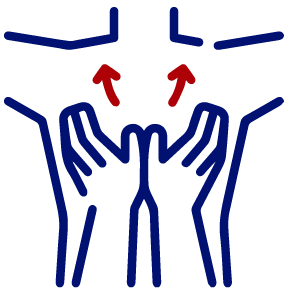
What Are Headaches And Migraines?
Headaches and migraines encompass a spectrum of neurological disorders, each with its distinct characteristics. Generally, headaches involve pain in the head or neck region, varying in intensity, duration, and accompanying symptoms. Migraines, a specific type of headache, are characterized by moderate to severe throbbing pain, often accompanied by additional symptoms such as nausea, sensitivity to light or sound, and visual disturbances known as auras. Delving into the details of what constitutes headaches and migraines is crucial for informed awareness, accurate diagnosis, and tailored treatment approaches.
Different Types Of Headaches
- Tension-type Headaches: Characterized by mild to moderate, non-throbbing pain. Often feels like a tight band around the head described in a crown or rams horn pattern.
- Migraines: Intense, throbbing pain often on one side of the head, accompanied by nausea, sensitivity to light, and sound.
- Cluster Headaches: Intense, severe pain around one eye, occurring in clusters or cycles.
- Sinus Headaches: Pain in the forehead, cheekbones, or bridge of the nose.
What Are The Symptoms?
Identifying symptoms related to headaches and migraines is crucial for understanding and addressing underlying issues. Here’s a summary of common symptoms associated with these conditions:

Dull, Aching Head Pain
A persistent, throbbing discomfort in the head characterized by a dull and aching sensation.

Muscle Tenderness
Sensitivity or soreness in the muscles surrounding the head and neck area, often contributing to tension headaches

Nausea and Vomiting
A feeling of queasiness or an urge to vomit, commonly accompanying severe headaches or migraines.

Nasal Congestion
Blockage or stuffiness in the nasal passages, which can be associated with certain types of headaches, particularly migraines.

Pressure
A sensation of pressure or tightness in the head, contributing to the overall discomfort associated with various headache types.

Facial Pain
Pain or discomfort localized in the facial area, often accompanying certain headache types or sinus-related issues.
Causes And Risk Factors
The origins of headaches and migraines can result from various factors and risks. Grasping these elements is vital for effective prevention and treatment.
What Are The Causes?
The causes of headaches and migraines presents unique challenges that require customized approaches for relief and recovery.
- Muscle Tension: Tension-type headaches are often associated with muscle contractions in the head and neck.
- Neurological Factors: Abnormalities in the brain and nervous system can contribute to various types of headaches, including migraines.
- Sinus Inflammation: Sinus headaches are linked to inflammation in the sinuses, often due to sinusitis.
- Medication Overuse: Rebound headaches can occur when medications, especially pain relievers, are overused.
- Menstruation: Hormonal fluctuations, specifically a drop in estrogen levels in relation to the menstrual cycle, can trigger migraines in some women.
- Pregnancy: Hormonal changes during pregnancy can influence headache occurrence.
- Environmental Factors: Factors such as bright lights, loud noises, strong smells, and weather changes can contribute to headache episodes.
- Dehydration and Hunger: Inadequate fluid intake and low blood sugar levels can lead to headaches.
- Poor Posture: Prolonged periods of poor posture can strain the neck and upper back muscles, leading to tension-type headaches.
- Jaw Clenching: Stress, anxiety, or dental issues can lead to jaw clenching, exerting pressure on the head and neck muscles.
What Are The Risk Factors?
Identifying the risk factors associated with chronic pain is essential for preemptive measures. These factors play pivotal roles in determining the likelihood of developing issues and discomfort.
- Age: The risk of chronic pain tends to increase with age, as wear and tear on the body accumulate.
- Genetics: Some individuals may be genetically predisposed to conditions that cause chronic pain.
- Occupational Factors: Certain occupations that involve repetitive motions or physical strain may elevate the risk of chronic pain.
- Lifestyle Choices: Sedentary lifestyles, poor nutrition, and smoking can contribute to chronic pain development.
- Traumatic Experiences: Previous traumatic experiences, such as accidents or surgeries, may increase the likelihood of chronic pain.
How Are Headaches And Migraines Diagnosed?
Unraveling the mystery of headaches and migraines starts with accurate diagnosis. Understanding the intricate diagnostic process is crucial for tailored treatment and effective management.
- Magnetic Resonance Imaging (Mri): Non-invasive imaging using strong magnetic fields and radio waves to detect structural abnormalities or vascular issues related to headaches.
- Erythrocyte Sedimentation Rate (Esr): Blood test measuring the rate at which red blood cells settle, indicating potential inflammation relevant to certain headache conditions.
- Ct Scan: X-ray imaging providing detailed cross-sectional views to detect structural abnormalities, bleeding, or tumors associated with headaches.
- Digital Subtraction Angiography: Invasive imaging with contrast dye to visualize blood vessels, assisting in identifying vascular abnormalities linked to headaches and migraines

How Can We Treat Headaches And Migraines?
We at Highlands Family Chiropractic are committed to providing effective treatment approaches for relief from headaches and migraines. Explore our treatment options:
Schedule Your Appointment Today
Contact us today to book a free 15-minute consultation with our Chiropractor in Highlands Ranch! We look forward to getting you on the path to optimal health and wellness.



